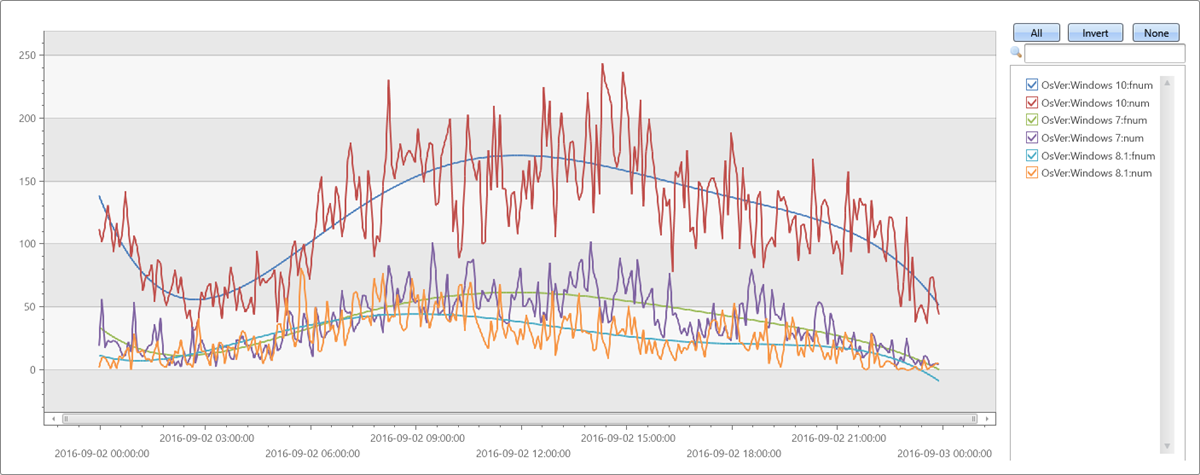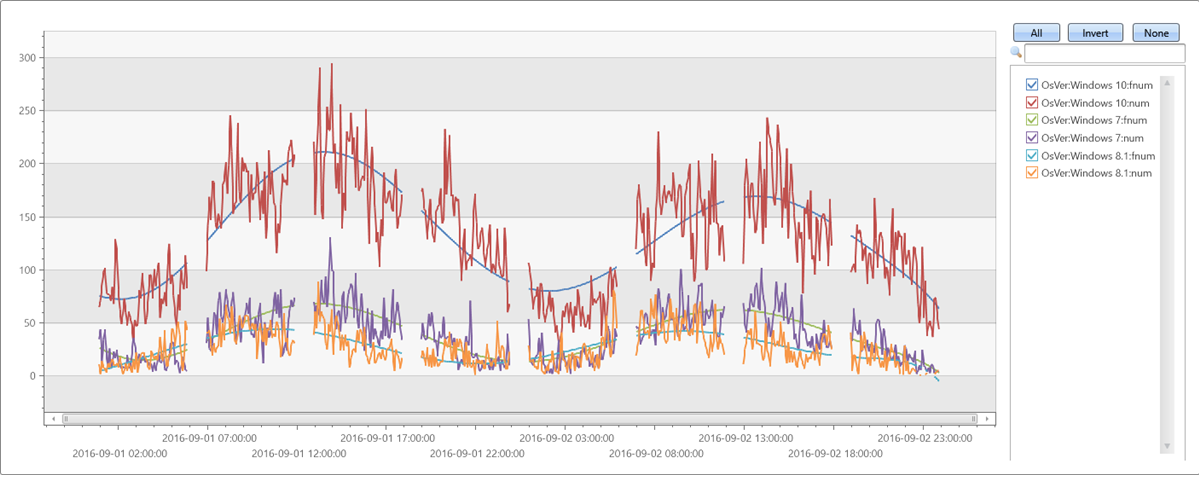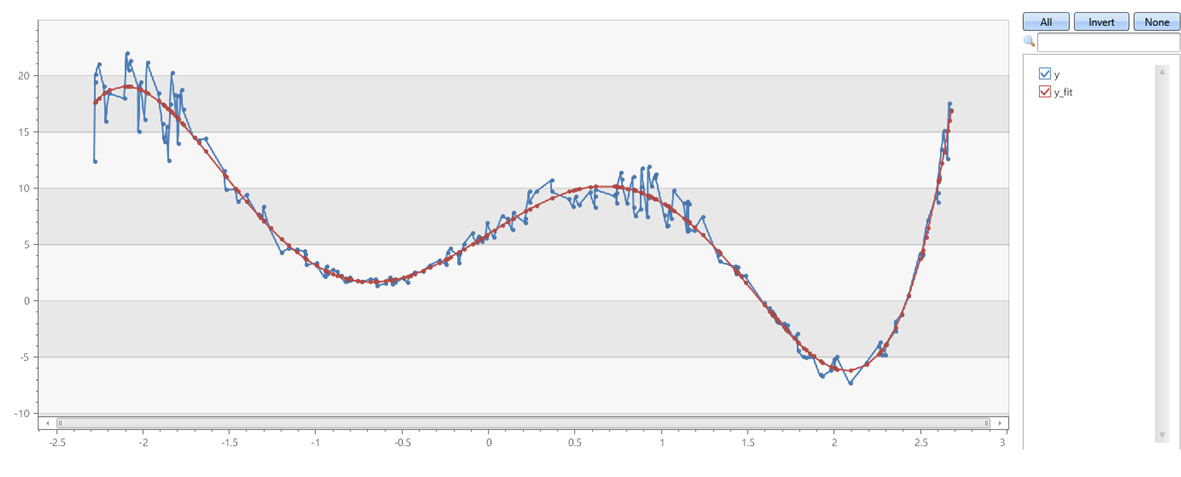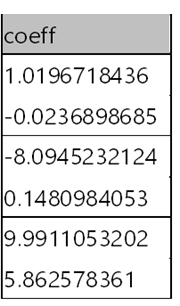series_fit_poly_fl()
Platí pro: ✅Microsoft Fabric✅Azure Data Explorer
Funkce series_fit_poly_fl() je uživatelem definovaná funkce (UDF), která na řadu používá polynomické regrese. Tato funkce přebírá tabulku obsahující více řad (dynamická číselná pole) a vygeneruje nejvhodnější polynomický polynom pro každou řadu pomocí polynomické regrese. Tato funkce vrátí polynomické koeficienty i interpolované polynomy v rozsahu řady.
Poznámka:
- Místo funkce popsané v tomto dokumentu použijte nativní funkci series_fit_poly( ). Nativní funkce poskytuje stejné funkce a je lepší pro výkon a škálovatelnost. Tento dokument je k dispozici pouze pro referenční účely.
- Pro lineární regresi rovnoměrně rozložené řady vytvořené operátorem make-series použijte nativní funkci series_fit_line().
Požadavky
- Modul plug-in Pythonu musí být v clusteru povolený. To se vyžaduje pro vložený Python použitý ve funkci.
- Modul plug-in Pythonu musí být v databázi povolený. To se vyžaduje pro vložený Python použitý ve funkci.
Syntaxe
T | invoke series_fit_poly_fl(, y_series y_fit_series, fit_coeff, stupeň, [ x_series ], [ x_istime ])
Přečtěte si další informace o konvencích syntaxe.
Parametry
| Název | Type | Požadováno | Popis |
|---|---|---|---|
| y_series | string |
✔️ | Název sloupce vstupní tabulky obsahující závislé proměnné. To znamená, že série se hodí. |
| y_fit_series | string |
✔️ | Název sloupce pro uložení nejvhodnější řady. |
| fit_coeff | string |
✔️ | Název sloupce pro uložení nejlepších polynomových koeficientů. |
| stupeň | int |
✔️ | Požadované pořadí polynomu pro přizpůsobení. Například 1 pro lineární regresi, 2 pro kvadratickou regresi atd. |
| x_series | string |
Název sloupce obsahujícího nezávislou proměnnou, tedy x nebo časovou osu. Tento parametr je volitelný a je nutný pouze pro nerovnoměrně rozloženou řadu. Výchozí hodnota je prázdný řetězec, protože x je redundantní pro regresi rovnoměrně rozložené řady. | |
| x_istime | bool |
Tento parametr je potřeba pouze v případě, že je zadán x_series a jedná se o vektor data a času. |
Definice funkce
Funkci můžete definovat vložením jejího kódu jako funkce definovanou dotazem nebo vytvořením jako uložené funkce v databázi následujícím způsobem:
Definujte funkci pomocí následujícího příkazu let. Nejsou vyžadována žádná oprávnění.
Důležité
Příkaz let nemůže běžet samostatně. Musí následovat příkaz tabulkového výrazu. Pokud chcete spustit funkční příklad, podívejte se na příkladyseries_fit_poly_fl().
let series_fit_poly_fl=(tbl:(*), y_series:string, y_fit_series:string, fit_coeff:string, degree:int, x_series:string='', x_istime:bool=False)
{
let kwargs = bag_pack('y_series', y_series, 'y_fit_series', y_fit_series, 'fit_coeff', fit_coeff, 'degree', degree, 'x_series', x_series, 'x_istime', x_istime);
let code = ```if 1:
y_series = kargs["y_series"]
y_fit_series = kargs["y_fit_series"]
fit_coeff = kargs["fit_coeff"]
degree = kargs["degree"]
x_series = kargs["x_series"]
x_istime = kargs["x_istime"]
def fit(ts_row, x_col, y_col, deg):
y = ts_row[y_col]
if x_col == "": # If there is no x column creates sequential range [1, len(y)]
x = np.arange(len(y)) + 1
else: # if x column exists check whether its a time column. If so, normalize it to the [1, len(y)] range, else take it as is.
if x_istime:
x = pd.to_numeric(pd.to_datetime(ts_row[x_col]))
x = x - x.min()
x = x / x.max()
x = x * (len(x) - 1) + 1
else:
x = ts_row[x_col]
coeff = np.polyfit(x, y, deg)
p = np.poly1d(coeff)
z = p(x)
return z, coeff
result = df
if len(df):
result[[y_fit_series, fit_coeff]] = df.apply(fit, axis=1, args=(x_series, y_series, degree,), result_type="expand")
```;
tbl
| evaluate python(typeof(*), code, kwargs)
};
// Write your query to use the function here.
Příklady
Následující příklady používají operátor invoke ke spuštění funkce.
Přizpůsobit polynomu pátého řádu na běžnou časovou řadu
Pokud chcete použít funkci definovanou dotazem, vyvoláte ji po definici vložené funkce.
let series_fit_poly_fl=(tbl:(*), y_series:string, y_fit_series:string, fit_coeff:string, degree:int, x_series:string='', x_istime:bool=False)
{
let kwargs = bag_pack('y_series', y_series, 'y_fit_series', y_fit_series, 'fit_coeff', fit_coeff, 'degree', degree, 'x_series', x_series, 'x_istime', x_istime);
let code = ```if 1:
y_series = kargs["y_series"]
y_fit_series = kargs["y_fit_series"]
fit_coeff = kargs["fit_coeff"]
degree = kargs["degree"]
x_series = kargs["x_series"]
x_istime = kargs["x_istime"]
def fit(ts_row, x_col, y_col, deg):
y = ts_row[y_col]
if x_col == "": # If there is no x column creates sequential range [1, len(y)]
x = np.arange(len(y)) + 1
else: # if x column exists check whether its a time column. If so, normalize it to the [1, len(y)] range, else take it as is.
if x_istime:
x = pd.to_numeric(pd.to_datetime(ts_row[x_col]))
x = x - x.min()
x = x / x.max()
x = x * (len(x) - 1) + 1
else:
x = ts_row[x_col]
coeff = np.polyfit(x, y, deg)
p = np.poly1d(coeff)
z = p(x)
return z, coeff
result = df
if len(df):
result[[y_fit_series, fit_coeff]] = df.apply(fit, axis=1, args=(x_series, y_series, degree,), result_type="expand")
```;
tbl
| evaluate python(typeof(*), code, kwargs)
};
//
// Fit fifth order polynomial to a regular (evenly spaced) time series, created with make-series
//
let max_t = datetime(2016-09-03);
demo_make_series1
| make-series num=count() on TimeStamp from max_t-1d to max_t step 5m by OsVer
| extend fnum = dynamic(null), coeff=dynamic(null), fnum1 = dynamic(null), coeff1=dynamic(null)
| invoke series_fit_poly_fl('num', 'fnum', 'coeff', 5)
| render timechart with(ycolumns=num, fnum)
Výstup

Testování nepravidelných časových řad
Pokud chcete použít funkci definovanou dotazem, vyvoláte ji po definici vložené funkce.
let series_fit_poly_fl=(tbl:(*), y_series:string, y_fit_series:string, fit_coeff:string, degree:int, x_series:string='', x_istime:bool=False)
{
let kwargs = bag_pack('y_series', y_series, 'y_fit_series', y_fit_series, 'fit_coeff', fit_coeff, 'degree', degree, 'x_series', x_series, 'x_istime', x_istime);
let code = ```if 1:
y_series = kargs["y_series"]
y_fit_series = kargs["y_fit_series"]
fit_coeff = kargs["fit_coeff"]
degree = kargs["degree"]
x_series = kargs["x_series"]
x_istime = kargs["x_istime"]
def fit(ts_row, x_col, y_col, deg):
y = ts_row[y_col]
if x_col == "": # If there is no x column creates sequential range [1, len(y)]
x = np.arange(len(y)) + 1
else: # if x column exists check whether its a time column. If so, normalize it to the [1, len(y)] range, else take it as is.
if x_istime:
x = pd.to_numeric(pd.to_datetime(ts_row[x_col]))
x = x - x.min()
x = x / x.max()
x = x * (len(x) - 1) + 1
else:
x = ts_row[x_col]
coeff = np.polyfit(x, y, deg)
p = np.poly1d(coeff)
z = p(x)
return z, coeff
result = df
if len(df):
result[[y_fit_series, fit_coeff]] = df.apply(fit, axis=1, args=(x_series, y_series, degree,), result_type="expand")
```;
tbl
| evaluate python(typeof(*), code, kwargs)
};
let max_t = datetime(2016-09-03);
demo_make_series1
| where TimeStamp between ((max_t-2d)..max_t)
| summarize num=count() by bin(TimeStamp, 5m), OsVer
| order by TimeStamp asc
| where hourofday(TimeStamp) % 6 != 0 // delete every 6th hour to create unevenly spaced time series
| summarize TimeStamp=make_list(TimeStamp), num=make_list(num) by OsVer
| extend fnum = dynamic(null), coeff=dynamic(null)
| invoke series_fit_poly_fl('num', 'fnum', 'coeff', 8, 'TimeStamp', True)
| render timechart with(ycolumns=num, fnum)
Výstup

Polynom pátého řádu s šumem na osách x &y
Pokud chcete použít funkci definovanou dotazem, vyvoláte ji po definici vložené funkce.
let series_fit_poly_fl=(tbl:(*), y_series:string, y_fit_series:string, fit_coeff:string, degree:int, x_series:string='', x_istime:bool=False)
{
let kwargs = bag_pack('y_series', y_series, 'y_fit_series', y_fit_series, 'fit_coeff', fit_coeff, 'degree', degree, 'x_series', x_series, 'x_istime', x_istime);
let code = ```if 1:
y_series = kargs["y_series"]
y_fit_series = kargs["y_fit_series"]
fit_coeff = kargs["fit_coeff"]
degree = kargs["degree"]
x_series = kargs["x_series"]
x_istime = kargs["x_istime"]
def fit(ts_row, x_col, y_col, deg):
y = ts_row[y_col]
if x_col == "": # If there is no x column creates sequential range [1, len(y)]
x = np.arange(len(y)) + 1
else: # if x column exists check whether its a time column. If so, normalize it to the [1, len(y)] range, else take it as is.
if x_istime:
x = pd.to_numeric(pd.to_datetime(ts_row[x_col]))
x = x - x.min()
x = x / x.max()
x = x * (len(x) - 1) + 1
else:
x = ts_row[x_col]
coeff = np.polyfit(x, y, deg)
p = np.poly1d(coeff)
z = p(x)
return z, coeff
result = df
if len(df):
result[[y_fit_series, fit_coeff]] = df.apply(fit, axis=1, args=(x_series, y_series, degree,), result_type="expand")
```;
tbl
| evaluate python(typeof(*), code, kwargs)
};
range x from 1 to 200 step 1
| project x = rand()*5 - 2.3
| extend y = pow(x, 5)-8*pow(x, 3)+10*x+6
| extend y = y + (rand() - 0.5)*0.5*y
| summarize x=make_list(x), y=make_list(y)
| extend y_fit = dynamic(null), coeff=dynamic(null)
| invoke series_fit_poly_fl('y', 'y_fit', 'coeff', 5, 'x')
|fork (project-away coeff) (project coeff | mv-expand coeff)
| render linechart
Výstup

